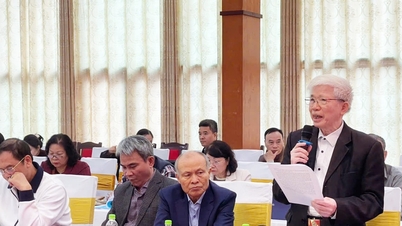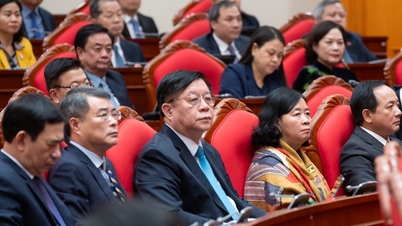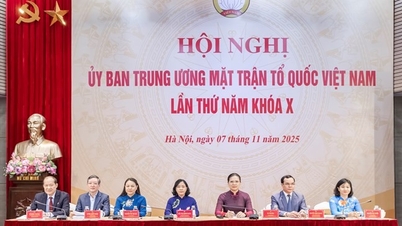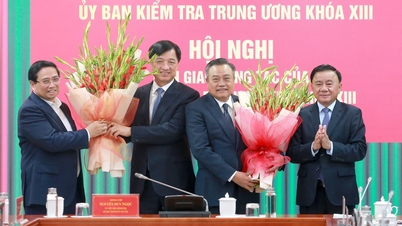Vietnam News Agency respectfully introduces comments on the draft documents of the 14th National Party Congress by Associate Professor - Doctor Pham Thi Hong Diep, Deputy Head of the Faculty of Political Economy, University of Economics, Vietnam National University, Hanoi.
Over the past decade, Vietnam has achieved remarkable results in growth and poverty reduction.
The draft Political Report submitted to the 14th National Congress of the Communist Party of Vietnam clearly states: “Political institutions are key, economic institutions are central, other institutions are very important.” This policy demonstrates the inheritance and development of innovative thinking, while affirming that development institutions are the central pillar in the country's development strategy for the 2026-2035 period, especially emphasizing the leading role of economic institutions in productivity, innovation and national competitiveness.
However, the development process is still hindered by many “institutional bottlenecks” such as overlapping legal systems, unequal business environments, limited policy enforcement capacity, and unclear decentralization and accountability mechanisms. These limitations weaken the motivation of the private sector, stifle innovation and affect the competitiveness of the economy .
In the context of digital transformation, green economy, knowledge economy and deep integration, the need for institutional improvement is more urgent than ever. A modern development institution is not only a complete legal framework but also a restructuring of the relationship between the State, market and society, creating a favorable environment for sustainable growth.
Developments in the Party's thinking
Through eight Congresses since the milestone of Comprehensive Renovation in 1986 (from the 6th Congress to the 13th Congress), the Party's awareness of economic institutions has continuously developed, from an administrative management mechanism to a complete socialist-oriented market economic institution.
If the 6th Congress paved the way for innovation in thinking, the 9th Congress established the theoretical foundation of the socialist-oriented market economic institution, and the 10th-11th Congress continued the viewpoints of perfecting the institutional structure.
By the 12th-13th Congresses, institutional thinking had reached the level of modernization, integration, and development creation. This was a consistent process, reflecting the Party's vision in building a dynamic, transparent, and effective economic institution, creating a foundation for sustainable growth and enhancing national competitiveness in the new era.
The policy of "continuing to build and perfect comprehensively and synchronously the institutions for rapid and sustainable development of the country; in which the political institution is the key, the economic institution is the focus, and other institutions are very important" in the draft Political Report submitted to the 14th National Congress of the Communist Party of Vietnam demonstrates the strategic vision of the Communist Party of Vietnam in the transition period to a new era of development - the era of digital economy, green economy and deep international integration.
First of all, this is the inheritance and development of the institutional innovation thinking that has been formed through many Congresses. If the previous Congresses focused on perfecting the socialist-oriented market economic institution, this Draft Political Report broadens the vision, considering the development institution as a comprehensive, interconnected system of political-economic-social institutions, ensuring the harmonious operation of the entire socio-economic system.
Second, this policy affirms the decisive role of institutions in rapid and sustainable development. Domestic and foreign practices show that countries with transparent and dynamic institutions capable of promoting innovation and protecting the legitimate rights of economic entities have higher productivity and competitiveness.
Identifying political institutions as key demonstrates the need to strengthen leadership capacity and ensure political stability - the foundation of development; while placing economic institutions as the focus affirms that the economy is the pillar that creates material resources for development.
Third, this policy has profound practical significance in the context of Vietnam entering a new development phase with many challenges: slowing growth, weak innovation, low competitiveness, strong climate change and digital transformation. A synchronous, transparent and effective development institution will be a prerequisite to unlock resources, especially the private sector, promote sustainable development and enhance national status.
Fourth, this policy reflects the thinking of “institution-based development” - considering institutions not only as a management tool, but also as a driving force for development, ensuring economic growth goes hand in hand with social progress and environmental protection. This is a new development in the Party’s thinking, in line with modern governance trends and the goal of making Vietnam a developed, high-income country by 2045.
Major economic institutional bottlenecks
Firstly, the legal framework and economic policies are still overlapping. The Vietnamese legal system currently has more than 300 laws and codes with many important legal documents having been promulgated, but one of the key obstacles in perfecting the socialist-oriented market economic institution in Vietnam is the overlapping situation. For example, in the field of land-investment-bidding, the density of overlap is very high.
Therefore, reviewing and adjusting to overcome overlaps between the Land Law and the Bidding Law, especially in the articles related to "investors," "joint ventures," "economic organizations" and "land use projects," is very necessary for the socialist-oriented market economic institution to operate more effectively.
Second, there are institutional bottlenecks in ownership rights in a socialist-oriented market economy. In the context of building a socialist-oriented market economy, ownership rights - including tangible assets (such as land, factories, machinery) and intangible assets (such as copyrights, industrial property rights, patents, trademarks) - are key to ensuring efficient resource allocation and encouraging innovation.

Property rights institutions in Vietnam – both tangible and intangible – are at the intersection of theory and practice. For tangible assets, ownership limits and administrative procedures remain bottlenecks; for intangible assets, although the legal framework has been improved, the connection to capital markets, commercialization and business support systems remains incomplete.
Perfecting the ownership institution is both a condition to stimulate the private sector to develop more strongly and an important factor to enhance national competitiveness and promote innovation.
Third, the institutional framework for accessing resources such as capital, land and technology is still limited. In fact, most private enterprises have difficulty in obtaining credit due to lack of collateral, complicated documentation and higher interest rates than state-owned enterprises or foreign-invested enterprises.
Regarding the issue of land access, a 2024 survey by VCCI showed that nearly 74% of businesses had to postpone or cancel their business plans due to complicated land administrative procedures. In addition, the mechanism to support the transfer and application of new technologies is not really effective, making it difficult for the private sector to innovate and improve productivity. As a result, private enterprises find it difficult to accumulate enough resources to invest in innovation and participate deeply in the global value chain, thereby slowing down the process of improving competitiveness and reducing the role of the private sector in leading national economic growth.
Impact on innovation and national competitiveness
The private sector is currently an important pillar of the Vietnamese economy, contributing about 50% of GDP and creating jobs for nearly 85% of the workforce (source: VCCI, 2024). However, when institutions lack incentives for development - through complex administrative procedures and limited access to resources - private enterprises cannot play the role of innovation as expected. 35% of enterprises said they still have to "pay additional unofficial costs" to complete investment procedures (VCCI, 2024). Therefore, many enterprises only stop at the processing stage, lack investment in technology and do not have enough strength to lead higher value chains.
Regarding institutional quality, according to UNDP assessment, up to 60% of private enterprises said they were “discriminated” in accessing resources compared to state-owned enterprises (VCCI, 2024). These limitations hinder the formation of medium and large enterprises of sufficient scale to lead innovation and participate deeply in the global value chain - thereby not raising national competitiveness as expected.
In fact, the labor productivity of the domestic private sector in Vietnam is still only about 36% of the state sector and 22% of the FDI sector (VCCI, 2024). Although the private sector contributes greatly, most of them are still small enterprises, not strong enough to invest in R&D and high technology. If institutional bottlenecks are not removed, Vietnam will find it difficult to escape the "middle-income trap" and achieve a highly competitive position in the international arena.

In the context of digital transformation, green economy, knowledge economy and deep international integration, Vietnam needs to shape a new development institutional model that is more creative, modern and flexible, to meet the requirements of rapid, sustainable development and global integration. This institutional model must ensure the central role of the market, in parallel with the orientation and leadership of the State to create development, creating a favorable environment for innovation and enhancing national competitiveness.
First of all, institutions must be built in the direction of creation and marketization; in which the State does not deeply intervene in economic activities but focuses on policy making, perfecting the rules of the game and ensuring fair competition. The market needs to be given a leading role in allocating resources, especially capital, land, energy and data - factors that determine productivity in the digital age.
In addition, the new institutional model must be digital and green. Digital institutions require all public management activities and public services to be digitized, transparent and data-integrated, minimizing transaction costs for people and businesses.
Along with that, green institutions are the pillars for Vietnam to shift to a sustainable growth model, aiming for net zero emissions by 2050. It is necessary to form a green financial mechanism, carbon market and preferential policies for renewable energy projects and clean technology innovation.
Finally, Vietnam needs to build an effective knowledge-based and decentralized institution, in which knowledge, science and innovation become key driving forces. Legal mechanisms need to encourage businesses to invest in research and development (R&D), protect intellectual property, develop digital human resources and closely connect businesses, universities and research institutes.
At the same time, it is necessary to strengthen decentralization and accountability for local governments, helping economic institutions become more dynamic and adapt more quickly to global fluctuations and international integration standards.
In short, the institutional model that Vietnam needs to aim for in the new period is a creative-digital-green-knowledge-decentralized institution; in which the State plays the role of orientation and creation, the market is the center, enterprises are the subject of innovation and people are the center of development. This is the foundation for Vietnam to break through, catch up with the trend of the times and firmly enter the era of green, digital and knowledge development./.
Source: https://www.vietnamplus.vn/dot-pha-the-che-de-vuot-qua-diem-nghen-va-nang-cao-nang-luc-canh-tranh-quoc-gia-post1075549.vnp







![[Photo] Da Nang: Hundreds of people join hands to clean up a vital tourist route after storm No. 13](https://vphoto.vietnam.vn/thumb/1200x675/vietnam/resource/IMAGE/2025/11/07/1762491638903_image-3-1353-jpg.webp)





































































































Comment (0)